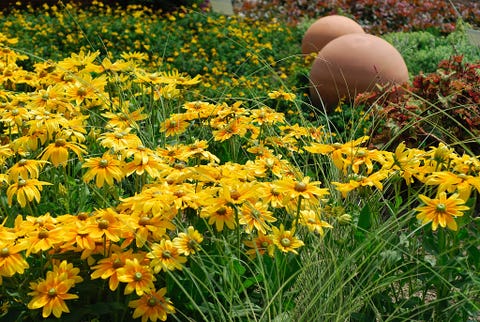Can You Plant Black Eyed Susans in a Pot

Instrinsic Perennial Gardens
With golden daisy-like blooms and cheery brown or black button centers, Black-eyed Susans are the perfect plant for months and months of reliable color. "Nearly everyone who has seen these plants loves them because of their almost smiley-face appearance and color," says plant breeder Brent Horvath, owner of Intrinsic Perennial Gardens. "They're not fussy, and they have a long bloom time, which makes them appealing for many gardeners."
Here's what you need to know to grow these happy, hardy plants:
What kinds of Black-eyed Susans should you plant?
Black-eyed Susans, also known by their botanical name of Rudbeckia hirta, are sometimes called gloriosa daisies. They grow in USDA Hardiness zones 3 to 9 (check your zone here). They come in a range of heights from 2 to 4 feet tall, though some types can be up to 7 feet tall. They typically spread about 18" to 3 feet wide in large clumps. They attract butterflies, and many types bloom from mid-summer until mid-fall. And good news: Deer and rodents generally leave them alone!
There are different species, some of which are perennial so they come back every year. But others are considered biennials (they last two years), so they're treated like annuals and replanted every year. Read the plant tag to be sure what kind you're getting.

The Top Varieties to Try:
- American Gold Rush (compact and disease-resistant)
- Indian Summer (large flowers)
- Autumn Sun (grows up to 7 feet tall)
- Prairie Sun (pretty pale yellow tips with green centers)
Where can I buy Black-eyed Susans?
Garden centers sell Black-eyed Susans from spring to fall. You also can find a wider selection of plants from online retailers. Look for plants that appear healthy with nice, green leaves, not yellow or brown and spotted foliage, which may indicate they're infected with a fungus called Septoria leaf spot. You may find seeds, too, for some varieties, which you can sow in the spring.
When should I plant Black-eyed Susans?
If it's a perennial type, get them in the ground in spring so they return next year. If you plant them in autumn, they'll provide pretty fall color but likely won't get their roots sufficiently established in time to survive the winter. No worries! Enjoy them for the season, and replant new ones next year.
How do I plant Black-eyed Susans?
Black-eyed Susans need full sun, which means about six hours per day. Dig a hole slightly bigger than the pot, and place the plant in the hole level with the soil in the top of the pot. You don't want the root ball to be buried too deeply or to be sticking up and exposing roots. Mulch around the base of the plant to preserve moisture, but don't cover the foliage (burying the leaves leads to disease). Or plant in a decorative pot to provide seasonal color. They're not heavy feeders, so you don't need to fertilize. Water well after planting.

ullstein bild Getty Images
How do I care for Black-eyed Susans?
Once established, Black-eyed Susan plants bloom better if you water occasionally during dry spells. You can deadhead, or clip off old blooms, to encourage the plant to keep blooming. Or you can leave the seed heads over the winter for the birds and to provide some interest in the winter landscape.
In early spring, don't be too quick to pull them up if it looks like nothing is happening. The growth comes from the base, so it takes time, especially after a hard winter. If you want to make more plants, cut off pieces from the edge of the plant with a garden spade in mid-spring and plant elsewhere in your garden. Or dig up the whole plant and divide into four pieces, says Horvath.
Pretty Black Eyed Susans for Your Garden

Goldsturm Black Eyed Susan plant
amazon.com
Perennial type for long-lasting blooms

Black-Eyed Susan
Pretty reddish-orange type of Black-eyed Susan

Black-eyed Susan seeds
Sprinkle seeds over your beds in spring.
Follow House Beautiful on Instagram .
Arricca Elin Sansone Arricca SanSone has written about health and lifestyle topics for Prevention, Country Living, Woman's Day, and more.
This content is created and maintained by a third party, and imported onto this page to help users provide their email addresses. You may be able to find more information about this and similar content at piano.io
Can You Plant Black Eyed Susans in a Pot
Source: https://www.housebeautiful.com/lifestyle/gardening/a28520004/how-to-plant-black-eyed-susans/